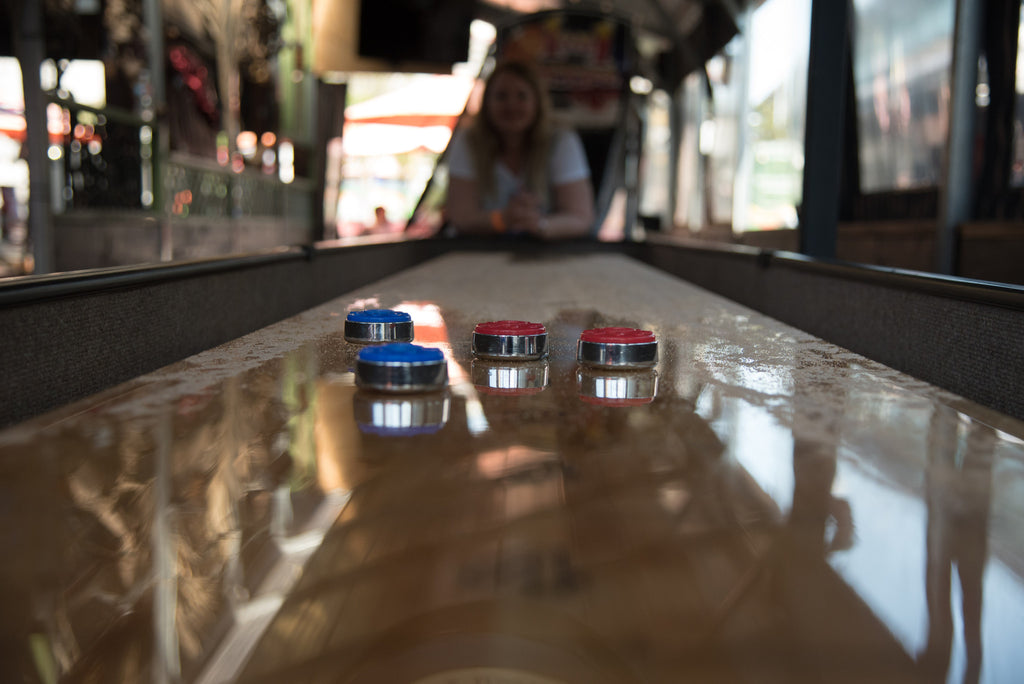For centuries, shuffleboard has been the game of choice for people who wanted a leisurely activity to play with friends, especially outside when the weather was nice. It remains a popular game, largely because the rules are so easy to learn. In this article, we’re going to cover these rules and explain the unique history that has brought shuffleboard into the 21st century.
The Beginnings of Shuffleboard
We can trace the first instances of shuffleboard back to the 15th century. Although it would eventually become a game for the wealthy, originally, shuffleboard was a popular activity in bars throughout England.
Players would take a “groat” (a large coin of the day used in Britain worth roughly four pence) and slide it down the table. Appropriately, the game was called “shove groat” or “slide groat.”
The next version of the game enlisted a silver penny. Again, the resulting name was simple but appropriate: “shove-penny” or, sometimes, “shovel-penny.” This was around the time that the game found popularity with people of all ages throughout Wiltshire, Winchester and Staffordshire. It was often the preferred form of entertainment in the great country houses that used to dot this part of England.
Shuffleboard in America
The game made it to the colonies sometime before the Revolutionary War and was played by both sides. In fact, the game is even mentioned in Arthur Miller’s famous novel, The Crucible.
You can even find shuffleboard mentioned in a case in New Hanover, Pennsylvania from 1848. In “The State vs. John Bishop”, the following question was posed to a judge: “Is shuffleboard a game of chance or a game of skill?”
In case this comes up at your next party, it may interest you to know that the presiding judge ruled the following:
"Though the defendant kept a public gaming table, as charged, and though diverse persons played thereat and bet spirituous liquors on the game, the game was not a game of chance, but was altogether a game of skill."
The Modernizing of Shuffleboard
The game finally evolved into its modern interpretation when cabinet-making companies like Hepplewhite and Duncan Phyfe and many others began focusing their beautiful inlaid cabinet work on high-end shuffleboard game tables for the upper-class of New York City.
These kinds of advancements made shuffleboard an actual sport in the minds of many. Were you to open a New York City newspaper in 1897, you would have found it took up as much space as baseball and prizefighting.
Shuffleboard tournaments drew huge crowds and garnered lots of hype. Colorful characters made names for themselves by dominating the shuffleboard circuit. People like “Big Ed” Morries, Alex Scott and George Lavender had plenty of fans who would follow them to tournaments in New York City, Jersey City, Hoboken, Newark and Philadelphia.
The sport even made it out to California by 1904 when a professional player, Gentleman Jim Corbett, had Doc Croll install a table in his Almedia club.
However, it wasn’t until the 40s and after the War that shuffleboard began to find a home in practically every big city in the entire country. No matter what their age or physical stature, everyone could join in on the fun.

In the 1950s, shuffleboard manufacturers began sponsoring major tournaments that found prominence all over the country. One of the tournaments listed had 576 teams signed up.
Celebrities like Harry James, Betty Grable, Alan Ladd and Merv Griffin loved the game, which, of course, convinced others too, as well.
The 60s were less hospitable to shuffleboard. Fierce completion amongst manufacturers, a lack of overall rules and no lack of options for occupying one’s time hurt shuffleboard’s popularity.
Nonetheless, the game has endured. In 1995, a National Shuffleboard Hall of Fame was even started. Many states also have their own, specific version.
The Rules of Shuffleboard
As we mentioned earlier, there are no official rules for shuffleboard, but the game is simple enough that you will find most people play it the same way, according to the following rules.
- Games can be played with either two (singles) or four (doubles) people.
- Cues are used to slide discs across the board. Where the discs land decides how many points the slider’s team gets. Players can also knock off other players’ discs.
- Discs are at least 9/16" thick but no thicker than an inch. Their diameters are six inches and must weigh no less than 11 ½ ounces. They cannot weigh more than 15 ounces.
- Cues should be longer than 6'3".
The scoring area is a triangle divided into six scoring areas:
- 2 x 7 points
- 2 x 8 points
- 1 x 10 points
- 1 x 10 points off
Games are usually played until one team hits 75 points. Other times, players agree to play a specific number of rounds, say 10 or 16, with the highest score being victorious.
There’s a reason shuffleboard has been around for so long. Even though it’s relatively easy to play, it provides a high level of competition and can be a lot of fun.















